Explainer
- Explainer
- Sovereign wealth
Trillion-dollar piggy banks: Inside the world of sovereign wealth
Norway’s is famously huge. Qatar used theirs to buy Harrods. How do sovereign wealth funds work? And why isn’t ours as big as Norway’s?
By October 1969, the rumour mill was in overdrive in Stavanger, a once-thriving port on Norway’s ruggedly Instagrammable west coast. The fishing industry that had supported families of hard-tackle seafarers and straight-talking townsfolk for generations was in long-term decline. Youth unemployment was endemic. But now, the talk went, there might be a lifebuoy bobbing on the horizon.
Some 300 kilometres offshore, almost halfway to Scotland, workers on the exploratory drilling rig Ocean Viking had been scooping up geological samples from 3 kilometres beneath the seabed. Phillips Petroleum, the Oklahoma-based outfit running the operation, had already wasted two years and millions of dollars on what the industry calls “dry wells”. This was their last attempt.
Conditions in the North Sea were, as usual, dire. Waves the height of seven-storey buildings battered the rig day and night. Cables perennially whined and whistled in the gale-force winds. It was dangerous work. Covered head to toe in mud that gushed up the bore, Ocean Viking’s workers, known in the trade as roustabouts and roughnecks, had to literally batten down the hatches and endure a storm so severe there were fears the whole rig might capsize. But it was worth the effort.
Not long after, rumours began to circulate in Stavanger. Local papers reported the rig had found something. Then they caught a whiff of a secret report. It supposedly revealed that this newly discovered field, “Ekofisk”, harboured a truly vast quantity of … oil. And it was true. On June 2, 1970, Phillips made it official. Not only was Ekofisk the first commercially viable oil deposit on the Norwegian continental shelf but it contained enough barrels, from one estimate, to supply Norway’s domestic demand for 21 years.
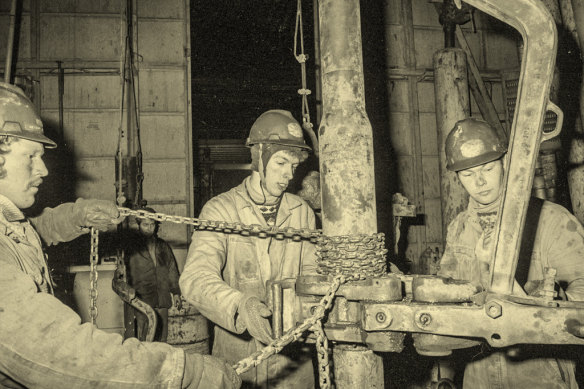
Oil drillers on an Ekofisk platform in the North Sea in 1973.Credit: Getty Images, digitally tinted
In the years that followed, Stavanger transformed into the hub of a burgeoning hydrocarbon industry, with a sister city in the drilling hub of Houston, Texas. The windfall transformed the rest of Norway, too, thanks to its decision to save oil and gas earnings in what’s known as a sovereign wealth fund. Now officially called the Government Pension Fund Global, but known to all Norwegians simply as the Oljefondet, or oil fund, it is one of the largest sovereign wealth funds in the world, worth in the region of $2.5 trillion, or nearly $500,000 for every Norwegian citizen.
Many resource-rich countries now have similar funds, from Saudi Arabia to Azerbaijan. Australia has its Future Fund, a minnow compared to some of those in the Gulf states, but still a handy $285 billion in assets under management. Britain has just started one, albeit limited to specific goals – including boosting green manufacturing – and pocket change at just $14 billion.
All these funds are different and do different things. Some are transparent and straitlaced; some are opaque. Some influence finance markets; others are restricted from meddling too deeply.
How do sovereign wealth funds operate? Which countries have them? And why doesn’t Australia, also resource-rich, have more cash in a special piggy bank?
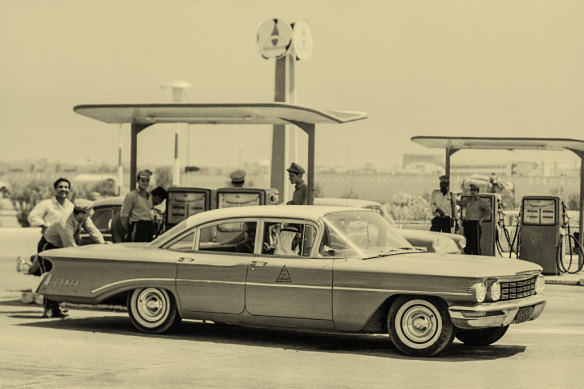
In Kuwait in 1963, an American car gets filled up by uniformed assistants at a petrol station. By this time, the nation was already sitting on a sovereign nest egg. Credit: Getty Images, digitally tinted
First, what is a sovereign wealth fund?
In 1951, Kuwait’s dusty main town was still roadless, its drinking water imported by traditional sailing dhow from neighbouring states. Sandstorms, or haboob, were frequent, summer temperatures nudged 50 degrees and there was “not a decent hotel in the sheikdom”, according to a 1953 article in Australia’s Townsville Bulletin. (The Sheraton chain arrived there in 1966, Hilton in 1969.) Yet change was afoot. The discovery of vast petrochemical reserves in the 1930s was finally starting to pay dividends. Critically, in 1953, Kuwait created an investment fund to manage its oil profits and fund a welfare state for its citizens. It was, in effect, the world’s first sovereign wealth fund.
Today, the Kuwait Investment Authority fund is solidly in the top 10 wealthiest sovereign funds globally, depending on the ebb and flow of its investments, not all of them sensible (more on that below). It is worth an estimated $1.2 trillion, making it one of the largest funds alongside those from other oil-rich Middle Eastern states as well as funds in China, Singapore and Norway.
Other resource-rich nations have followed suit. Among them, the petro states of Kazakhstan, the world’s 12th largest oil producer, with its Samruk-Kazyna, or National Welfare Fund; Brunei with its Investment Agency (42nd largest oil producer); and East Timor (80th) with its Timor-Leste Petroleum Fund. Botswana started a fund in 1994 to save revenue from diamond mining, now worth a nifty $7 billion. There are some 60 such funds tracked by a member organisation called the International Forum of Sovereign Wealth Funds.
More than a quarter of the total sovereign-fund wealth on any given day is held by Kuwait, Qatar, Saudi Arabia and the United Arab Emirates, though the China Investment Corporation has grown from around $350 billion in assets in 2007 to around $2 trillion today, vying with Norway’s for the title of world’s wealthiest.
While the funds share some common values, they diverge greatly in their make-up and purpose. Even defining them can be tricky – economists don’t necessarily even agree on what is and what isn’t one.
Some, such as Norway’s, call themselves pension funds but aren’t really in the business of providing pensions. Nor are sovereign wealth funds necessarily limited to those owned by nations: there’s Alaska’s Permanent Fund, funded by oil and mining revenue; Wyoming established its Permanent Wyoming Mineral Trust Fund in 1974; New Mexico started its New Mexico State Investment Council in 1958. Alberta in Canada has a $33 billion oil-based Heritage Savings Trust Fund. Locally, the NSW Future Generations fund was set up in 2018 with an initial investment of $10 billion.
Opposition promises two new future funds
On April 10, 2025 the Coalition pledged to open two new future funds for Australia, should it win government. These would be called the Future Generations Fund and the Regional Australia Future Fund and they would capture 80 per cent of commodity windfalls. These funds could then be used to pay down debt, and invest in “nation-building initiatives that will drive growth in the regions”, according to finance spokesperson Jane Hume. As in Norway, where funds are largely protected from current-day government spending demands, Hume says these new funds would ensure that “windfall gains will not be able to be used for the current expenditure”.
“There is no such thing as a ‘typical’ sovereign wealth fund,” writes financial analyst Andrew Rozanov, who is credited with coining the term in 2005. “They differ in structure, governance, policy objectives, risk-return profiles, investment horizons, eligible asset classes and instruments, not to mention levels of transparency and accessibility.”
The Qatari Investment Authority underpins a lifestyle for its citizens unimaginable for many of the non-citizens who live and work in the gas-rich Gulf state.
That said, we can work with the general definition that a sovereign wealth fund is a handsome pot of money – often generated by a windfall such as a resources boom or budget surplus – that is controlled by a government to improve the lives of its citizens, usually long into the future. These piggy banks are – usually – managed separately from the sovereign central bank, ministry of finance and treasuries; they invest in multiple assets; and they typically have no explicit liabilities, unlike pension funds. They are usually seen as very long-term investments and are often protected, sometimes constitutionally, from politicians wanting to raid them for short-term funding.
Some are set up with the aim of improving infrastructure and creating jobs. Some focus on improving the standard of living through increased welfare benefits and public services. The Qatari Investment Authority was established in 2005 to underpin a lifestyle for its citizens unimaginable for many of the non-citizens who live and work in the gas-rich Gulf state, where they enjoy free health care and education.
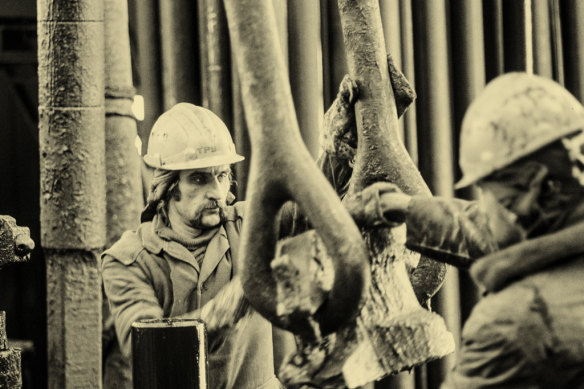
Workers in a petrol plant in Kazakhstan in 1990.Credit: Getty Images, digitally tinted
Some use the cash to diversify their economies, into tourism or other industries. In Britain, the newly elected Labour government has pledged to fund a $14-billion National Wealth Fund to encourage investment in green industries including steel, ports, factories, hydrogen and batteries. Most funds are also seen as a buffer against hard times, such as global economic shock or a collapse in resource prices.
They are occasionally viewed with suspicion, says Dr Pramod Kumar Yadav, a lecturer of finance at the University of Sydney Business School. When such funds began to emerge in droves in the early 2000s, he says, “They were seen in a very negative light because a state-owned investment vehicle is, by nature, political.”
“If you look at the Middle East, it has been a push towards trying to attract manufacturing and technology to the region, to diversify away from oil and gas.”
Gabriele Lattanzio, senior lecturer in finance at the University of Melbourne
Indeed, the way they invest tells a lot about the political agenda of the government behind them, says Gabriele Lattanzio, a senior lecturer in finance at the University of Melbourne. “The way Chinese funds have operated for the last 15 years, it has been about going after tech companies abroad. If you look at the Middle East, it has been a push towards trying to attract manufacturing and technology to the region, to diversify away from oil and gas.”
Norway’s oil fund is the backbone of that country’s welfare state. After that fateful discovery at Ekofisk, there was talk of what to do with the money for several years. A fully fledged proposal for resource profits to flow into a savings fund was tabled in Norway’s parliament in 1983; in 1990, a new law ensured that funds would be regularly transferred from revenue to a savings pot.
Headed by former hedge-fund manager Nicolai Tangen, who’s been called Norway’s “trillion-dollar man”, the fund today enables the state to pay generous unemployment benefits (at nearly two-thirds of previous income), to cap healthcare charges at around $400 a year, to give new parents a year of shared parental leave, and to fund high-quality schooling and (virtually free) university. Still, it’s not too generous.
Even as the fund grows, taxes are still significant; so too is the cost of living. It’s a trade-off Norwegians mostly accept, partly because of a cultural bias against profligate spending, embodied in a code of social-religious modesty called janteloven (a “mean and disdainful attitude to extraordinary achievements”) and partially because they will need the money for future generations on that distant day when the oil finally runs out. “Our aim is to make Norway a qualitatively better society to live in,” said foreign minister Knut Frydenlund in 1976. “We don’t have a final policy on how to do this. There are no models to go by. We are playing it very cautiously.”
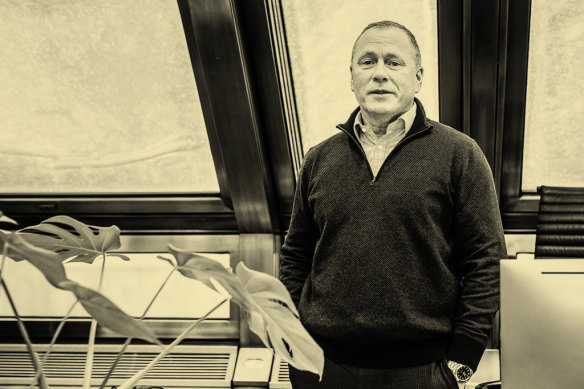
Nicolai Tangen, who heads Norway’s sovereign wealth fund, in Oslo in 2021.Credit: Getty Images, digitally tinted
How does Australia’s sovereign wealth fund fit in?
Australia’s Future Fund was originally set up with two specific purposes: to strengthen the Commonwealth’s long-term financial position and to cover the cost, in the future, of defined-benefit pension payments owed to public servants as they retired and aged, a kind of pension that has now largely disappeared.
“Norway is highly reliant on oil for exports and they have a tiny population [5.5 million]. Comparisons between Norway and Australia are very misleading.”
Sinclair Davidson, professor of institutional economics at RMIT
By 2004, the government was aware of the growing gulf between these liabilities and its ability to cover them when they inevitably came due, partly because not enough had been saved and partly because those eligible for the pensions were living longer than had been predicted. So in 2006 the government, guided by then-treasurer Peter Costello, established the Future Fund to make these payments, with deposits from government budget surpluses and the sale of Telstra, totalling around $60.5 billion.
Why doesn’t resource-rich Australia have a fund the size of Norway’s? One answer is that we didn’t set one up in the 1990s. Another is that when we did start the Future Fund, it was not fed from an ongoing revenue stream but from a one-off sale of Telstra and some budget surpluses that were short-lived, evaporating with the global financial crisis in 2008. Says Craig Thorburn, who has been at the Future Fund since its inception and is now its director of research and insights: “The world was in a pretty stark position, so the money stopped coming into the Future Fund, and it hasn’t come back.” That said, the fund also now manages several subsidiary funds including a $23 billion medical research fund, a $4.8 billion drought fund, a $4.6 billion disaster fund and the $10 billion Housing Australia Future Fund. Funds under management now total some $285 billion.
“I often get asked why Australia doesn’t have a fund like Norway,” says RMIT Professor of Institutional Economics Sinclair Davidson. “Part of the issue is that Norway is highly reliant on oil for exports and they have a tiny population [5.5 million]. Comparisons between Norway and Australia are very misleading.”
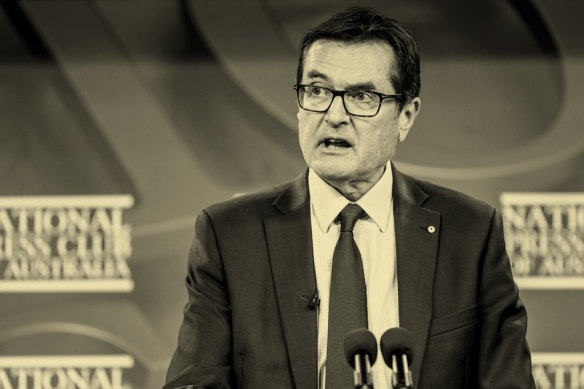
In June, Greg Combet started a five-year term as chair of Australia’s Future Fund. Credit: Alex Ellinghausen, digitally tinted
Indeed, economist Saul Eslake said in 2019: “Sovereign wealth funds are usually created in three or four ways: by persistent budget surpluses, which we don’t have; by selling assets, but we don’t have any left; by resource endowments, but the government doesn’t own them as they do in Norway or Saudi Arabia; or by running current account surpluses and managing the exchange rate [as China does], but we don’t do that.”
Lattanzio says the question is not about sovereign wealth funds themselves but about where the wealth is supposed to come from in the first place. “Let’s talk about the tax regime and the incredible national resources we have in this country. Should we rethink how royalties are levied, or how mining companies are taxed? The tax system, for sure, is uniquely favourable for miners, compared to many other developed economies. Should it be more aggressive? That’s a tricky question. It’s a trade-off between investments, commitments, geopolitical consideration, international trade consideration.”
Economist Dimitri Burshtein, meanwhile, doesn’t think we should have the Future Fund at all, arguing last year that it should be liquidated to pay off government debt. The fund had grown, he said, from one with a specific purpose (pension obligations) to spawn several under its umbrella. “While created for a virtuous purpose, the Future Fund has become a significant distortion to Australian public policy and public finances,” he wrote in a research paper for the Centre of Independent Studies, “managed by a variety of third-party asset managers who received more than $120 million in fees in 2022 for the privilege of managing taxpayer monies”.
He tells us today: “Like all bureaucracies set up for a particular narrow focus, they like to continuously expand their mandate. It was meant to start paying off [its obligations] around 2020, it was extended to 2026, and now the Future Fund people want to essentially extend it indefinitely.”
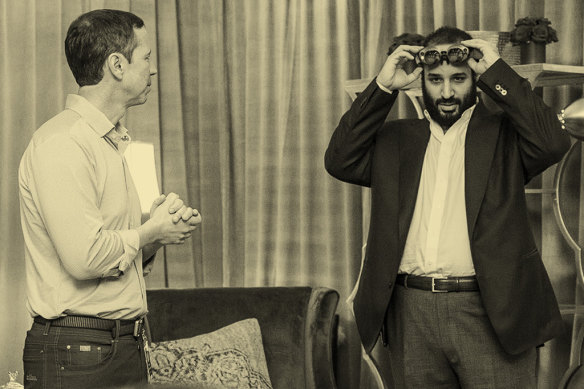
The Crown Prince of Saudi Arabia, Mohammed bin Salman – who also heads Saudi’s main sovereign fund – tries on a virtual-reality headset in California in 2018.Credit: Getty Images, digitally tinted
Why are sovereign wealth funds sometimes controversial?
Norway has strict and much-debated rules on how its oil wealth can be spent and invested. It has a list of companies it is barred from investing in, including those with ties to palm oil plantations, nuclear weapons, cluster munitions and tobacco. It cannot buy Norwegian companies, equities and real estate, lest it be exposed to a downturn in the local economy (a smaller sister fund invests locally). “Generally,” says Gabriele Lattanzio, “government ownership is associated with less innovation, with less creativity, less entrepreneurialism.”
Instead, Norway invests widely and globally, including in many of Australia’s largest listed companies. It publishes a list of its holdings and displays a prominent and ever-changing ticker of its total balance on its homepage. It is not immune from criticism, however: it has been pressured by environmental activists to divest its investments in companies that mismanage climate risk.
Other funds are less transparent in how they operate, where they invest and what their true goals are. Says Yadav: “When you look at the Abu Dhabi Investment Authority, or some of those other Middle Eastern sovereign wealth funds, they’re very focused on private companies, and that’s their way of not disclosing a lot of information. If I’m investing in the private space, then I’ll take all the credit when things are successful. But if a project doesn’t go through, nobody knows about it because you’re not required to disclose it.”
The expenditure of Azerbaijan’s State Oil Fund, SOFAZ, is “opaque”, concludes Kenan Aslanli in the Journal of Eurasian Studies. Kazakhstan’s National Fund offers little information on its governance, assets or investment strategies.
According to the US Department of State, there is no publicly available information about the size of Turkmenistan’s sovereign wealth fund, the Stabilization Fund, or how it is managed. “The sovereign wealth fund did not have a sound legal framework or disclose its source of funding and general approach to withdrawals,” it said in 2023. “It was unclear if the laws and regulations that do exist were followed in practice.”
The Saudi fund has invested in Uber, Heathrow Airport, Nintendo, Hollywood studios, French hotels, electric carmakers Tesla and Lucid Motors, spaceflight company Virgin Galactic.
Some investment decisions by the Gulf states can sometimes look like trophy-hunting. Over time, Qatar’s various asset managers have snapped up the department store Harrods, London’s iconic “Shard” office skyscraper, part of The Savoy hotel, the French soccer team Paris Saint-Germain, and stakes in Barclay’s Bank, the upmarket Sainsbury’s supermarket chain and New York’s Empire State Building.
Saudi’s Public Investment Fund, set up in 1971, is ultimately controlled by Crown Prince Mohammed bin Salman, Saudi Arabia’s de facto ruler since 2015, but the extent of his decision-making on the fund’s investment decisions is unknown. In recent years, the fund has invested in Uber, Heathrow Airport, Nintendo, Hollywood studios, French hotels, electric carmakers Tesla and Lucid Motors, spaceflight company Virgin Galactic and virtual-reality headset maker Magic Leap.
Domestically, it is a major investor in Neom, a futuristic 26,000-hectare city that will apparently incorporate a Blade Runner-like mirrored linear building called The Line, planned to span 170 kilometres at just 200 metres wide. Most recently, Saudi is planning to invest $60 billion in artificial intelligence.
It also, at times, seems to have gotten carried away. It was reportedly a $7 billion investor in WeWork, the shared-office-space company that collapsed from a valuation of nearly $80 billion in 2019 to nearly zero in 2023. And, indirectly, the fund lost its shirt on Zume, the Bay Area start-up once valued at $3.5 billion that attempted to short-circuit the normal pizza-delivery process by having robots bake pies in the backs of delivery vans. “The company quickly gave up on the cooking-while-driving model,” reported SFGate, “as cheese kept sliding around when the truck hit bumps in the road.”
Saudi Arabia has used its fund to purchase sporting prestige too. In 2021, it bought an 80 per cent stake in the soccer team Newcastle United, a sale opposed by the 19 other clubs in the Premier League amid accusations of sportswashing (seeking to distract from violations of human rights) by Amnesty International. Then there’s its foray into golf, with Saudi’s fund-backed LIV Golf League, which poached many of the best players from the rival PGA. There are now plans to host the Asian Winter Games in 2029, spraying desert mountains with snow.

Fans of Newcastle United football club, including one draped in a Saudi flag, after the Gulf state’s takeover of the club in 2021. Credit: Getty Images, digitally tinted
Kuwait has occasionally stumbled. In the 1980s, when Spain’s boom-and-bust economy was temporarily booming, the Kuwait Investment Office spent some $7 billion turning a paper company into a major corporation with interests in chemicals and property development. It subsequently went bust, 20,000 jobs were lost and Kuwait was left with little but an embarrassing legal battle.
Sometimes, funds come under fire for ethical reasons. Australia’s Future Fund has a list of businesses it won’t invest in, such as tobacco companies, but has been criticised for investing in weapons manufacturers. The Future Fund is also prohibited from “moving markets” – investing in a way that might unduly influence particular companies. “If we were to own a lot of Australian exposure we could actually be quite large owners of certain Australian companies,” says the fund’s Craig Thorburn. When the fund was established, he says, “The government was very concerned that we wouldn’t be involved in moving those types of markets in a way that would impact other investors.”
“When I’m walking around in town or at restaurants, people come and talk to me and then want to talk about the fund. There is huge ownership and pride.”
Nicolai Tangen, head of Norway’s Oljefondet
There are, occasionally, fears that sovereign wealth funds can be used in ways that are contrary to the interests of other states. During the Obama presidency, says Lattanzio, “They were trying to reduce the ability of foreign entities to get involved with corporate America. There was this worry, especially of China and the Middle East, getting into the ownership of large corporations and getting access to innovation”. In 1988, following a four-month investigation by its Monopolies and Mergers Commission, Britain ordered the Kuwait Investment Authority to sell down its stake in the newly privatised British Petroleum.
China’s $2 trillion China Investment Corp, the largest of its national funds, has this year been vacuuming up small and mid-size Japanese businesses, including a chain of therapy salons. Its motives are unknown. “Were China’s fund so inclined,” noted The New Yorker in 2007, “it could buy Ford, GM [General Motors], Volkswagen and Honda, and still have a little money left over for ice-cream.”

The Oslo offices of Equinor, formerly Statoil, an energy company majority owned by the Norwegian state.Credit: Alamy, digitally tinted
Meanwhile, while the Ekofisk oil field’s most productive days are in the past, it is nevertheless expected to keep pumping until at least 2050. The value of the fund it powers continues to climb ever higher: at last check its “ticker”, in Norwegian kroner, stood briefly at 18,540,249,101,461, a shade over $2.5 trillion.
“People are fixated by that number; some have it on their computer screens,” Nicolai Tangen told The Times last year. “Norwegian people are so immensely proud of that fund because it belongs to all of them. And I feel that because when I’m walking around in town or at restaurants, people come and talk to me and then want to talk about the fund. There is huge ownership and pride.”
Indeed, when Tangen accepted the role leading the fund in September 2020, he had planned to delete the ticker because of its focus on the short term (it can fluctuate by billions in a single day). But, in the end, he didn’t. “If I had there would have been a revolution.”
Get fascinating insights and explanations on the world’s most perplexing topics. Sign up for our weekly Explainer newsletter.
Let us explain
If you'd like some expert background on an issue or a news event, drop us a line at explainers@smh.com.au or explainers@theage.com.au. Read more explainers here.